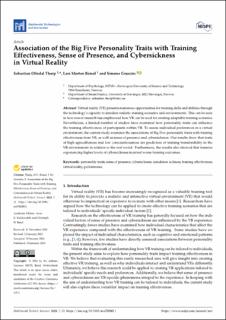| dc.contributor.author | Thorp, Sebastian | |
| dc.contributor.author | Rimol, Lars Morten | |
| dc.contributor.author | Grassini, Simone | |
| dc.date.accessioned | 2023-06-22T08:54:29Z | |
| dc.date.available | 2023-06-22T08:54:29Z | |
| dc.date.created | 2023-03-13T10:40:15Z | |
| dc.date.issued | 2023 | |
| dc.identifier.citation | Thorp, S. O., Rimol, L. M., & Grassini, S. (2023). Association of the Big Five Personality Traits with Training Effectiveness, Sense of Presence, and Cybersickness in Virtual Reality. Multimodal Technologies and Interaction, 7(2), 11. | en_US |
| dc.identifier.issn | 2414-4088 | |
| dc.identifier.uri | https://hdl.handle.net/11250/3072614 | |
| dc.description.abstract | Virtual reality (VR) presents numerous opportunities for training skills and abilities through the technology’s capacity to simulate realistic training scenarios and environments. This can be seen in how newer research has emphasized how VR can be used for creating adaptable training scenarios. Nevertheless, a limited number of studies have examined how personality traits can influence the training effectiveness of participants within VR. To assess individual preferences in a virtual environment, the current study examines the associations of Big Five personality traits with training effectiveness from VR, as well as sense of presence and cybersickness. Our results show that traits of high agreeableness and low conscientiousness are predictors of training transferability in the VR environment in relation to the real world. Furthermore, the results also showed that trainees experiencing higher levels of cybersickness incurred worse training outcomes | en_US |
| dc.language.iso | eng | en_US |
| dc.publisher | MDPI | en_US |
| dc.rights | Navngivelse 4.0 Internasjonal | * |
| dc.rights.uri | http://creativecommons.org/licenses/by/4.0/deed.no | * |
| dc.title | Association of the Big Five Personality Traits with Training Effectiveness, Sense of Presence, and Cybersickness in Virtual Reality | en_US |
| dc.type | Peer reviewed | en_US |
| dc.type | Journal article | en_US |
| dc.description.version | publishedVersion | en_US |
| dc.rights.holder | The authors | en_US |
| dc.subject.nsi | VDP::Teknologi: 500 | en_US |
| dc.subject.nsi | VDP::Samfunnsvitenskap: 200::Psykologi: 260 | en_US |
| dc.source.volume | 7 | en_US |
| dc.source.journal | Multimodal Technologies and Interaction | en_US |
| dc.source.issue | 2 | en_US |
| dc.identifier.doi | 10.3390/mti7020011 | |
| dc.identifier.cristin | 2133416 | |
| cristin.ispublished | true | |
| cristin.fulltext | original | |
| cristin.qualitycode | 1 | |

